TOYOTA YARIS HYBRID 2012 Owners Manual
Manufacturer: TOYOTA, Model Year: 2012, Model line: YARIS HYBRID, Model: TOYOTA YARIS HYBRID 2012Pages: 704, PDF Size: 27.58 MB
Page 631 of 704
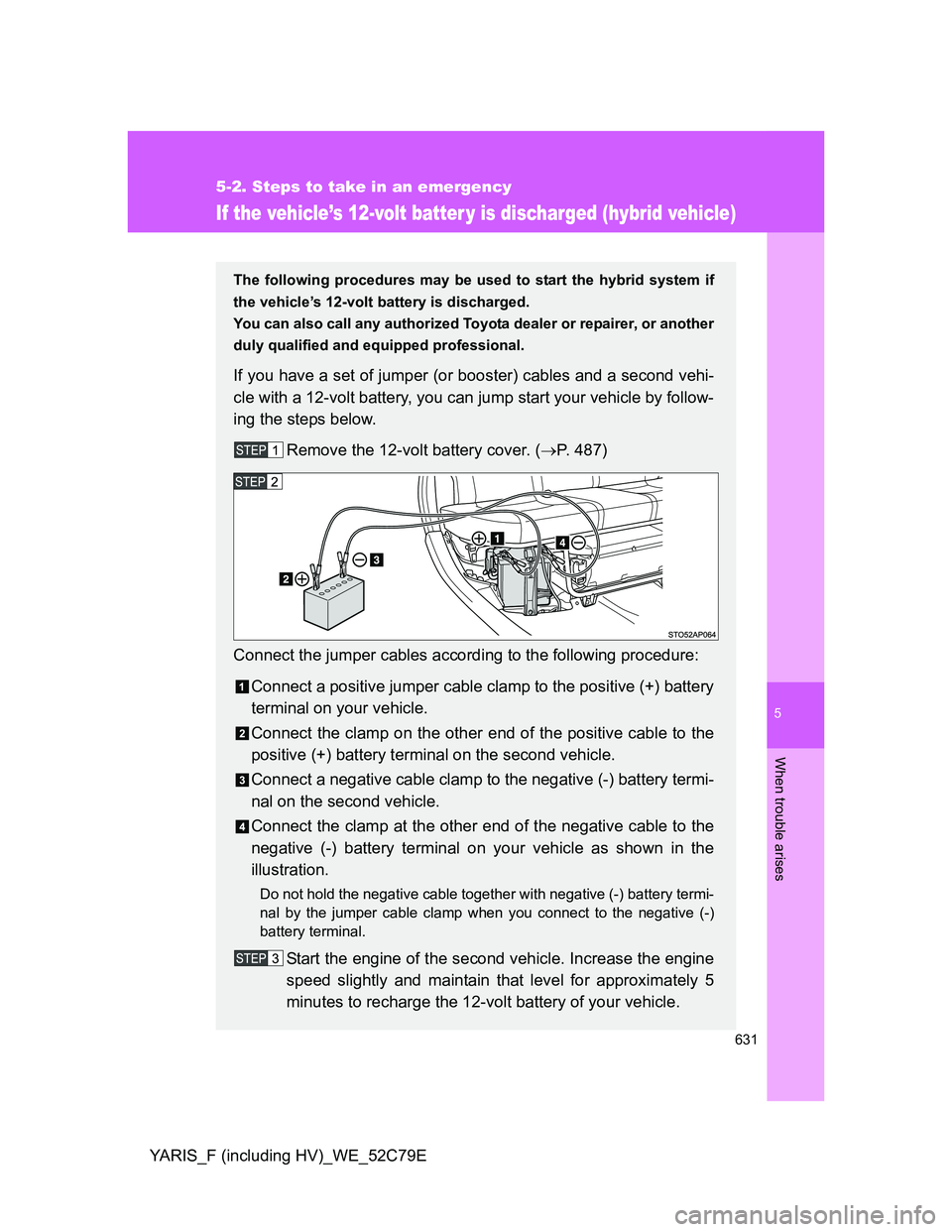
5
631
5-2. Steps to take in an emergency
When trouble arises
YARIS_F (including HV)_WE_52C79E
If the vehicle’s 12-volt batter y is discharged (hybrid vehicle)
The following procedures may be used to start the hybrid system if
the vehicle’s 12-volt battery is discharged.
You can also call any authorized Toyota dealer or repairer, or another
duly qualified and equipped professional.
If you have a set of jumper (or booster) cables and a second vehi-
cle with a 12-volt battery, you can jump start your vehicle by follow-
ing the steps below.
Remove the 12-volt battery cover. (P. 487)
Connect the jumper cables according to the following procedure:
Connect a positive jumper cable clamp to the positive (+) battery
terminal on your vehicle.
Connect the clamp on the other end of the positive cable to the
positive (+) battery terminal on the second vehicle.
Connect a negative cable clamp to the negative (-) battery termi-
nal on the second vehicle.
Connect the clamp at the other end of the negative cable to the
negative (-) battery terminal on your vehicle as shown in the
illustration.
Do not hold the negative cable together with negative (-) battery termi-
nal by the jumper cable clamp when you connect to the negative (-)
battery terminal.
Start the engine of the second vehicle. Increase the engine
speed slightly and maintain that level for approximately 5
minutes to recharge the 12-volt battery of your vehicle.
Page 632 of 704
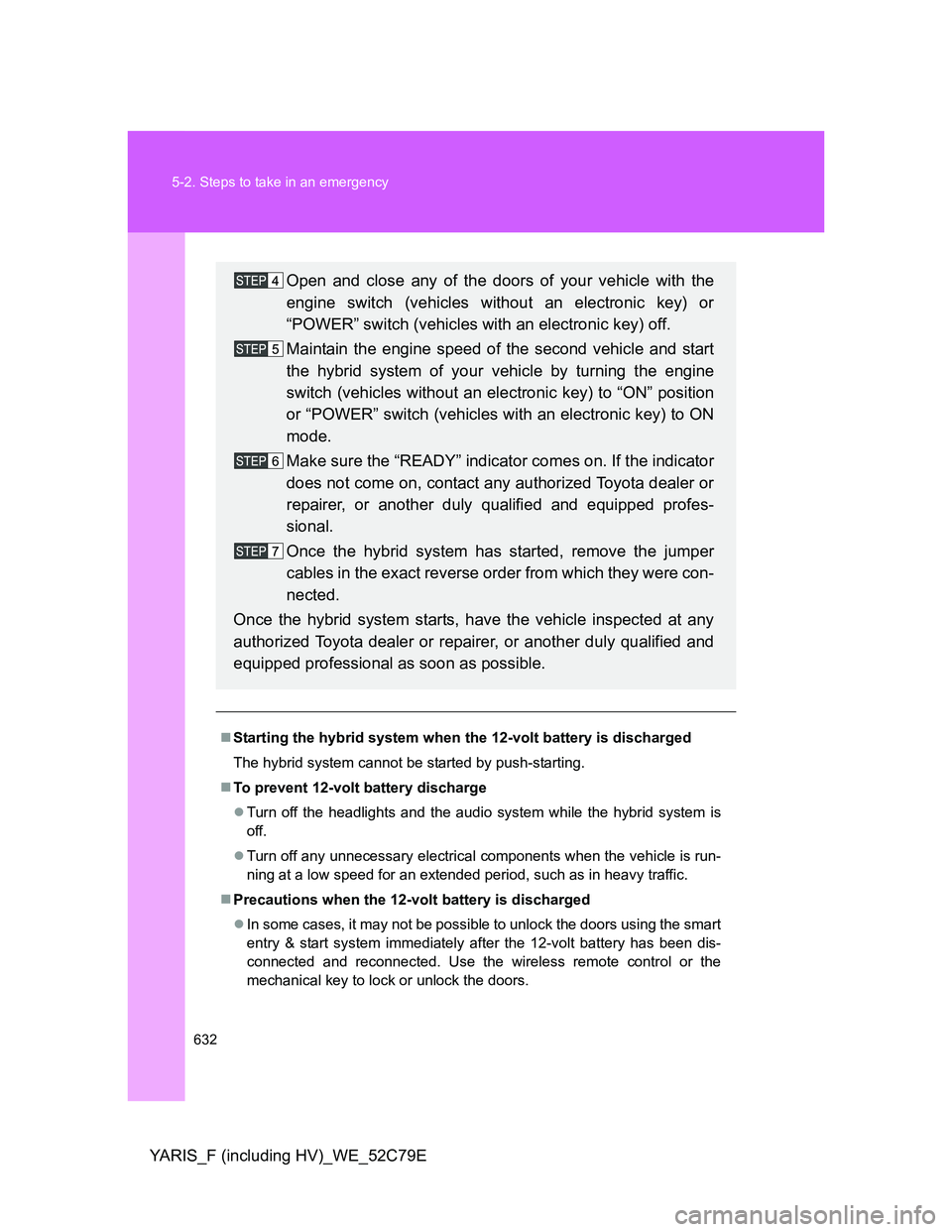
632 5-2. Steps to take in an emergency
YARIS_F (including HV)_WE_52C79E
Starting the hybrid system when the 12-volt battery is discharged
The hybrid system cannot be started by push-starting.
To prevent 12-volt battery discharge
Turn off the headlights and the audio system while the hybrid system is
off.
Turn off any unnecessary electrical components when the vehicle is run-
ning at a low speed for an extended period, such as in heavy traffic.
Precautions when the 12-volt battery is discharged
In some cases, it may not be possible to unlock the doors using the smart
entry & start system immediately after the 12-volt battery has been dis-
connected and reconnected. Use the wireless remote control or the
mechanical key to lock or unlock the doors.
Open and close any of the doors of your vehicle with the
engine switch (vehicles without an electronic key) or
“POWER” switch (vehicles with an electronic key) off.
Maintain the engine speed of the second vehicle and start
the hybrid system of your vehicle by turning the engine
switch (vehicles without an electronic key) to “ON” position
or “POWER” switch (vehicles with an electronic key) to ON
mode.
Make sure the “READY” indicator comes on. If the indicator
does not come on, contact any authorized Toyota dealer or
repairer, or another duly qualified and equipped profes-
sional.
Once the hybrid system has started, remove the jumper
cables in the exact reverse order from which they were con-
nected.
Once the hybrid system starts, have the vehicle inspected at any
authorized Toyota dealer or repairer, or another duly qualified and
equipped professional as soon as possible.
Page 633 of 704
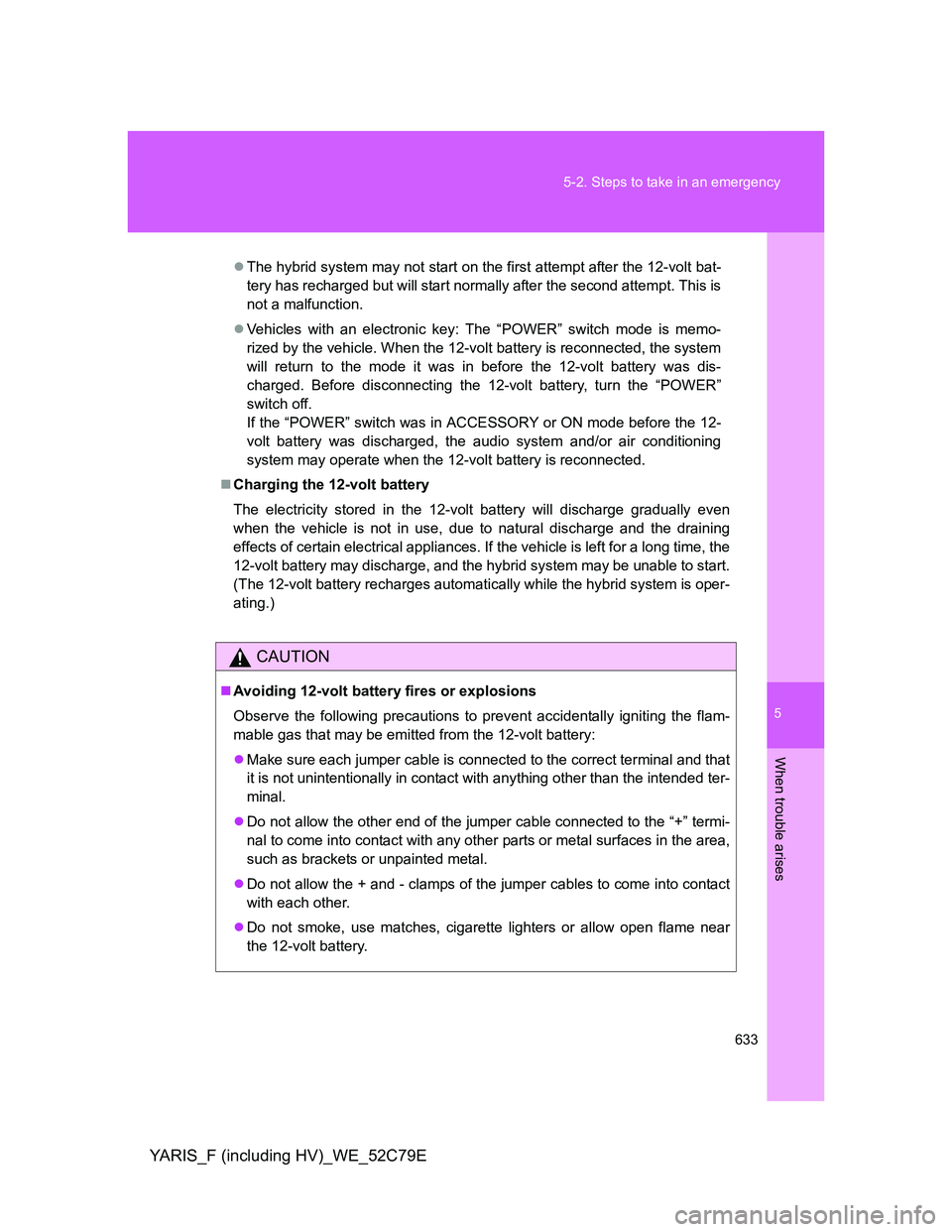
5
633 5-2. Steps to take in an emergency
When trouble arises
YARIS_F (including HV)_WE_52C79E
The hybrid system may not start on the first attempt after the 12-volt bat-
tery has recharged but will start normally after the second attempt. This is
not a malfunction.
Vehicles with an electronic key: The “POWER” switch mode is memo-
rized by the vehicle. When the 12-volt battery is reconnected, the system
will return to the mode it was in before the 12-volt battery was dis-
charged. Before disconnecting the 12-volt battery, turn the “POWER”
switch off.
If the “POWER” switch was in ACCESSORY or ON mode before the 12-
volt battery was discharged, the audio system and/or air conditioning
system may operate when the 12-volt battery is reconnected.
Charging the 12-volt battery
The electricity stored in the 12-volt battery will discharge gradually even
when the vehicle is not in use, due to natural discharge and the draining
effects of certain electrical appliances. If the vehicle is left for a long time, the
12-volt battery may discharge, and the hybrid system may be unable to start.
(The 12-volt battery recharges automatically while the hybrid system is oper-
ating.)
CAUTION
Avoiding 12-volt battery fires or explosions
Observe the following precautions to prevent accidentally igniting the flam-
mable gas that may be emitted from the 12-volt battery:
Make sure each jumper cable is connected to the correct terminal and that
it is not unintentionally in contact with anything other than the intended ter-
minal.
Do not allow the other end of the jumper cable connected to the “+” termi-
nal to come into contact with any other parts or metal surfaces in the area,
such as brackets or unpainted metal.
Do not allow the + and - clamps of the jumper cables to come into contact
with each other.
Do not smoke, use matches, cigarette lighters or allow open flame near
the 12-volt battery.
Page 634 of 704
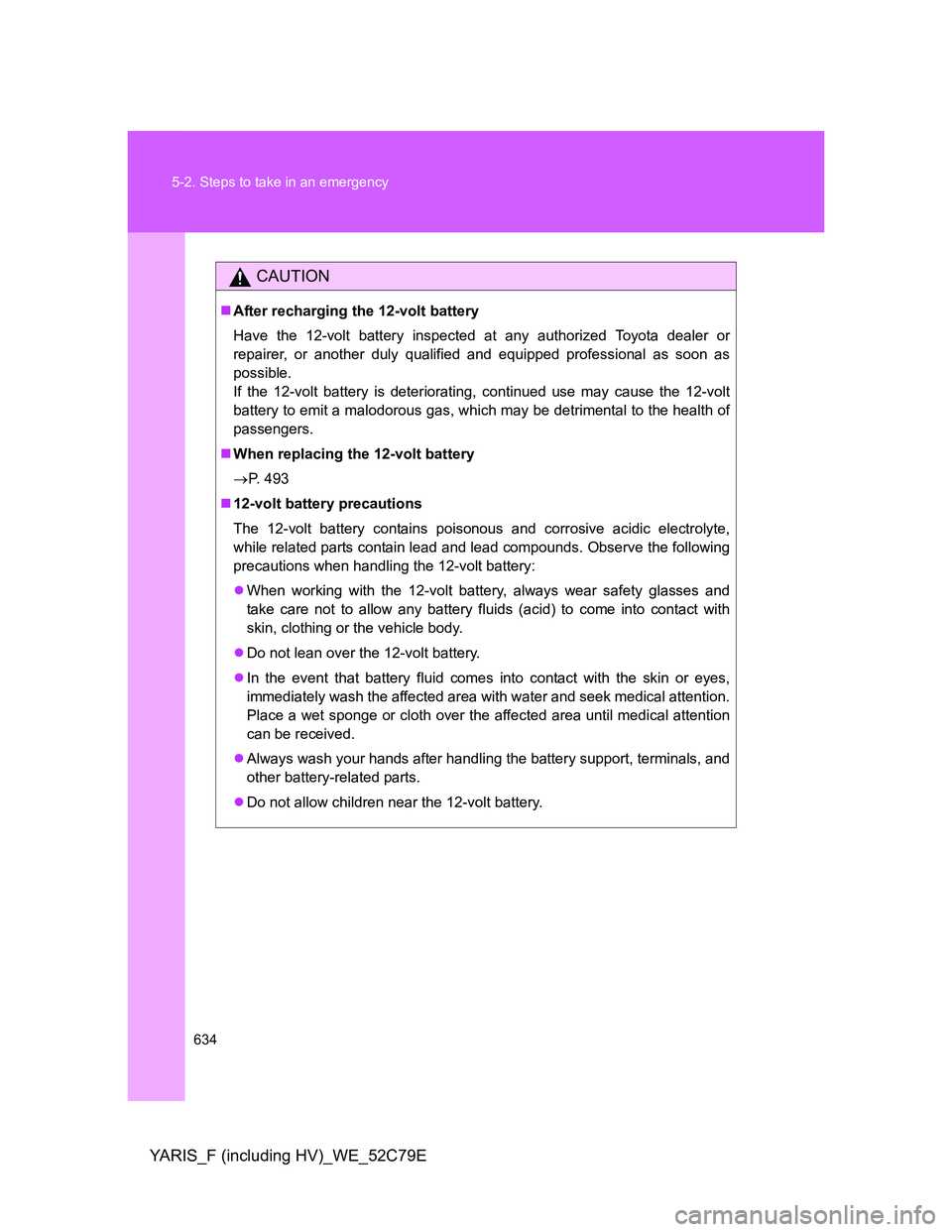
634 5-2. Steps to take in an emergency
YARIS_F (including HV)_WE_52C79E
CAUTION
After recharging the 12-volt battery
Have the 12-volt battery inspected at any authorized Toyota dealer or
repairer, or another duly qualified and equipped professional as soon as
possible.
If the 12-volt battery is deteriorating, continued use may cause the 12-volt
battery to emit a malodorous gas, which may be detrimental to the health of
passengers.
When replacing the 12-volt battery
P. 493
12-volt battery precautions
The 12-volt battery contains poisonous and corrosive acidic electrolyte,
while related parts contain lead and lead compounds. Observe the following
precautions when handling the 12-volt battery:
When working with the 12-volt battery, always wear safety glasses and
take care not to allow any battery fluids (acid) to come into contact with
skin, clothing or the vehicle body.
Do not lean over the 12-volt battery.
In the event that battery fluid comes into contact with the skin or eyes,
immediately wash the affected area with water and seek medical attention.
Place a wet sponge or cloth over the affected area until medical attention
can be received.
Always wash your hands after handling the battery support, terminals, and
other battery-related parts.
Do not allow children near the 12-volt battery.
Page 635 of 704
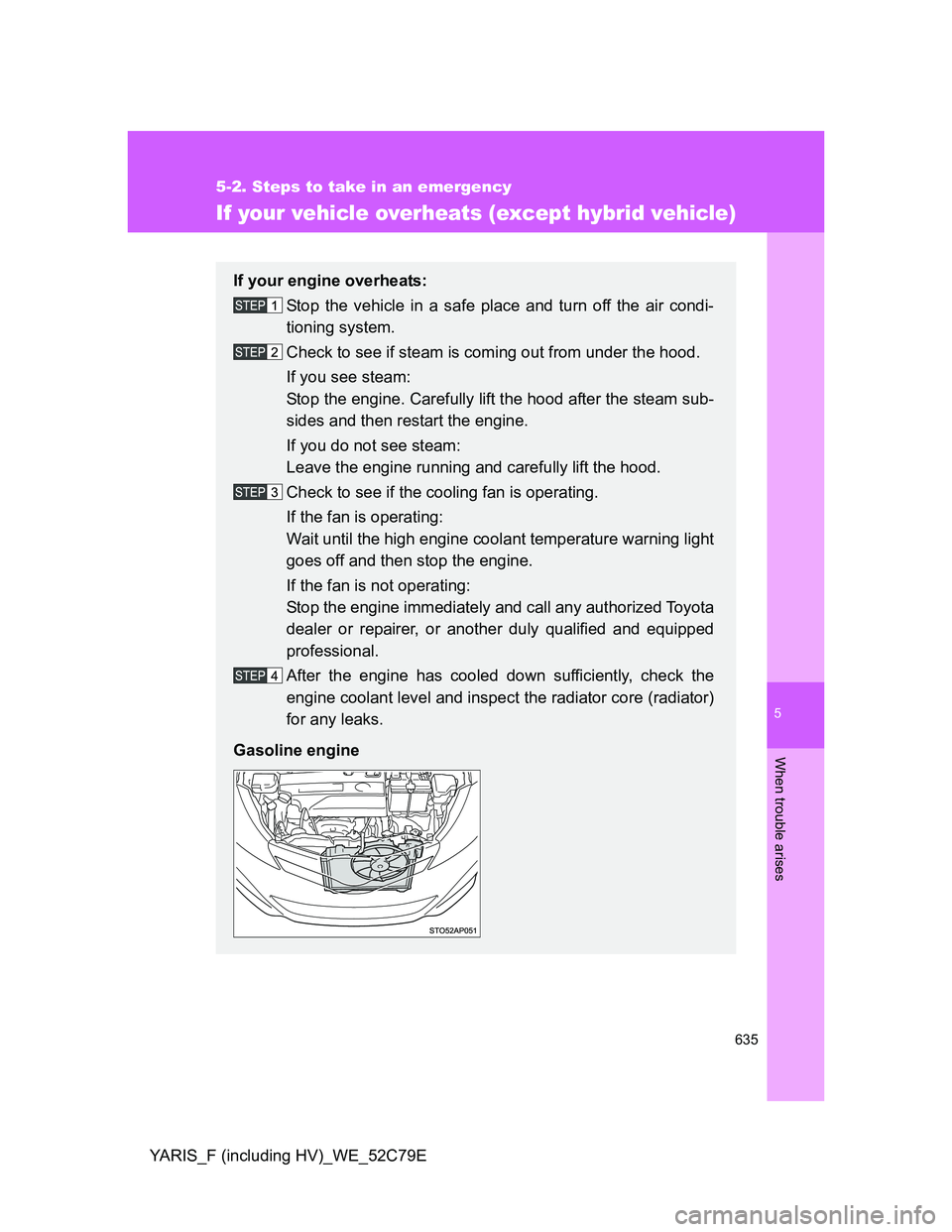
5
635
5-2. Steps to take in an emergency
When trouble arises
YARIS_F (including HV)_WE_52C79E
If your vehicle overheats (except hybrid vehicle)
If your engine overheats:
Stop the vehicle in a safe place and turn off the air condi-
tioning system.
Check to see if steam is coming out from under the hood.
If you see steam:
Stop the engine. Carefully lift the hood after the steam sub-
sides and then restart the engine.
If you do not see steam:
Leave the engine running and carefully lift the hood.
Check to see if the cooling fan is operating.
If the fan is operating:
Wait until the high engine coolant temperature warning light
goes off and then stop the engine.
If the fan is not operating:
Stop the engine immediately and call any authorized Toyota
dealer or repairer, or another duly qualified and equipped
professional.
After the engine has cooled down sufficiently, check the
engine coolant level and inspect the radiator core (radiator)
for any leaks.
Gasoline engine
Page 636 of 704
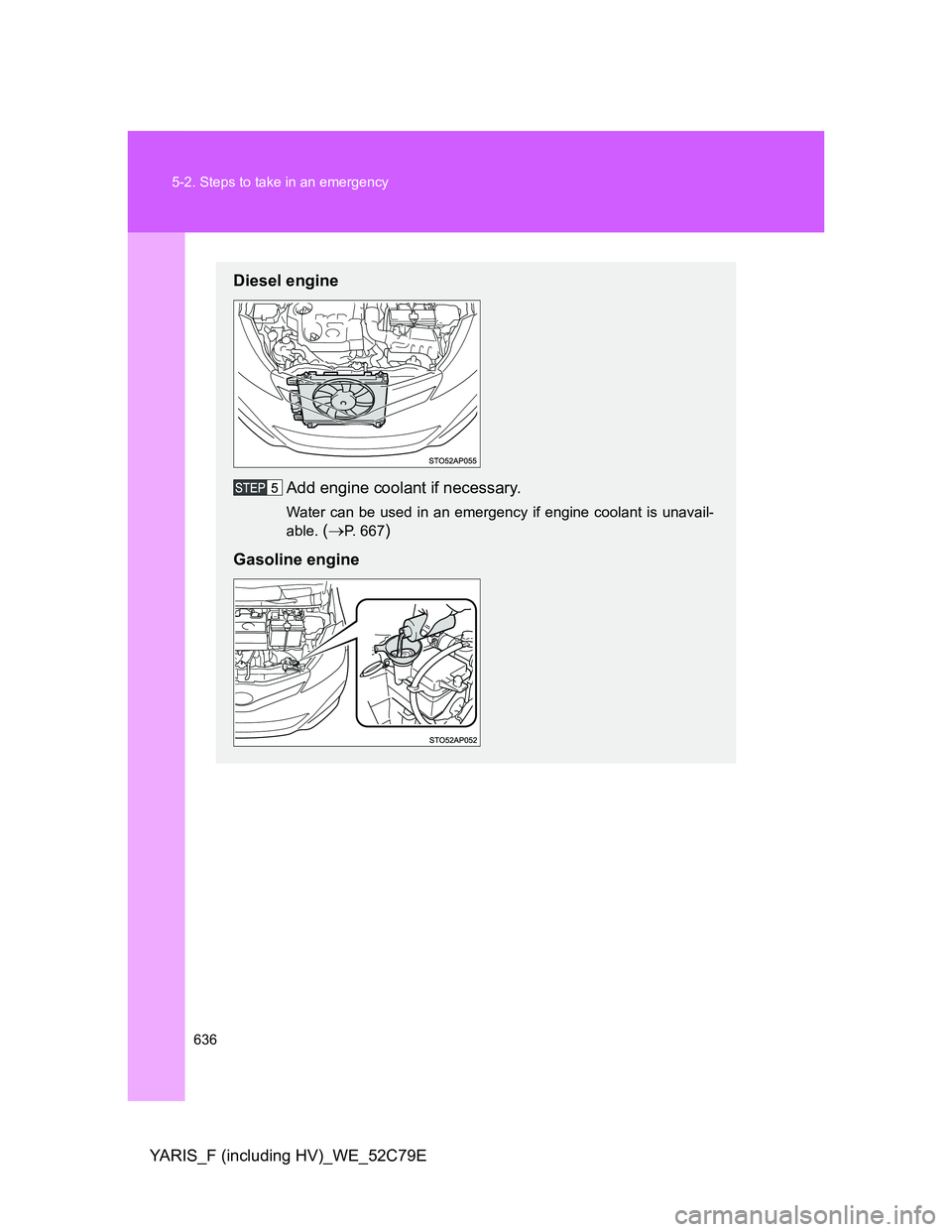
636 5-2. Steps to take in an emergency
YARIS_F (including HV)_WE_52C79E
Diesel engine
Add engine coolant if necessary.
Water can be used in an emergency if engine coolant is unavail-
able.
(P. 667)
Gasoline engine
Page 637 of 704
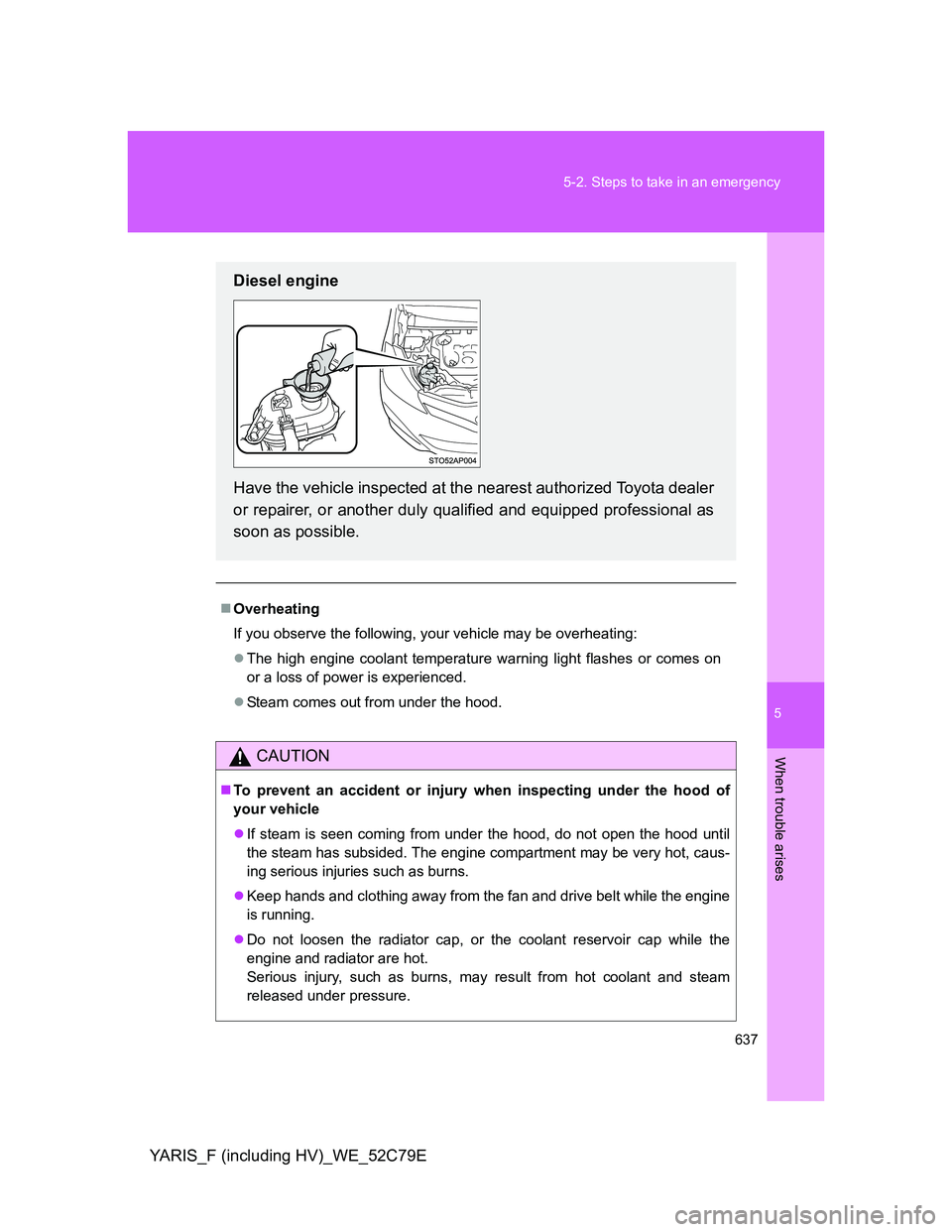
5
637 5-2. Steps to take in an emergency
When trouble arises
YARIS_F (including HV)_WE_52C79E
Overheating
If you observe the following, your vehicle may be overheating:
The high engine coolant temperature warning light flashes or comes on
or a loss of power is experienced.
Steam comes out from under the hood.
CAUTION
To prevent an accident or injury when inspecting under the hood of
your vehicle
If steam is seen coming from under the hood, do not open the hood until
the steam has subsided. The engine compartment may be very hot, caus-
ing serious injuries such as burns.
Keep hands and clothing away from the fan and drive belt while the engine
is running.
Do not loosen the radiator cap, or the coolant reservoir cap while the
engine and radiator are hot.
Serious injury, such as burns, may result from hot coolant and steam
released under pressure.
Diesel engine
Have the vehicle inspected at the nearest authorized Toyota dealer
or repairer, or another duly qualified and equipped professional as
soon as possible.
Page 638 of 704
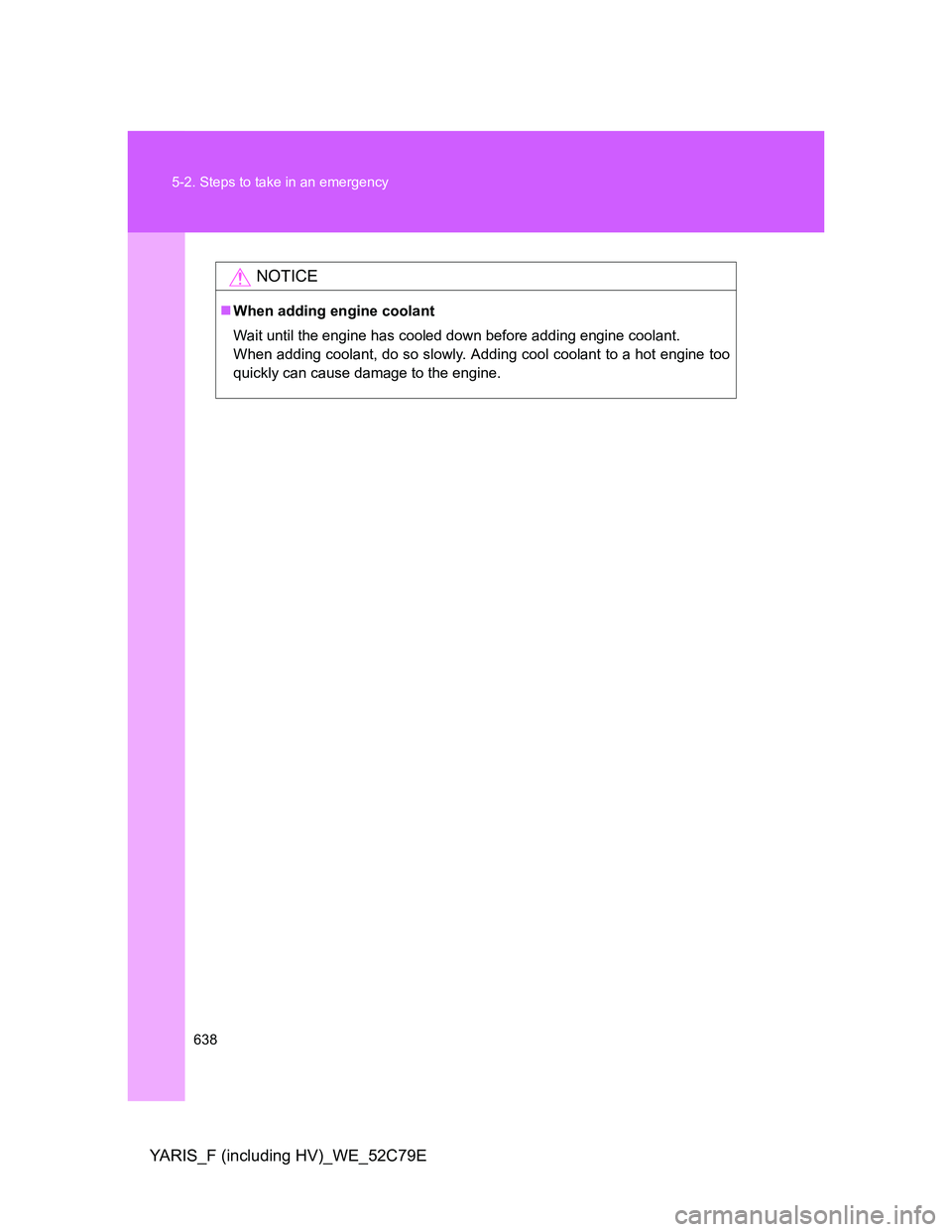
638 5-2. Steps to take in an emergency
YARIS_F (including HV)_WE_52C79E
NOTICE
When adding engine coolant
Wait until the engine has cooled down before adding engine coolant.
When adding coolant, do so slowly. Adding cool coolant to a hot engine too
quickly can cause damage to the engine.
Page 639 of 704
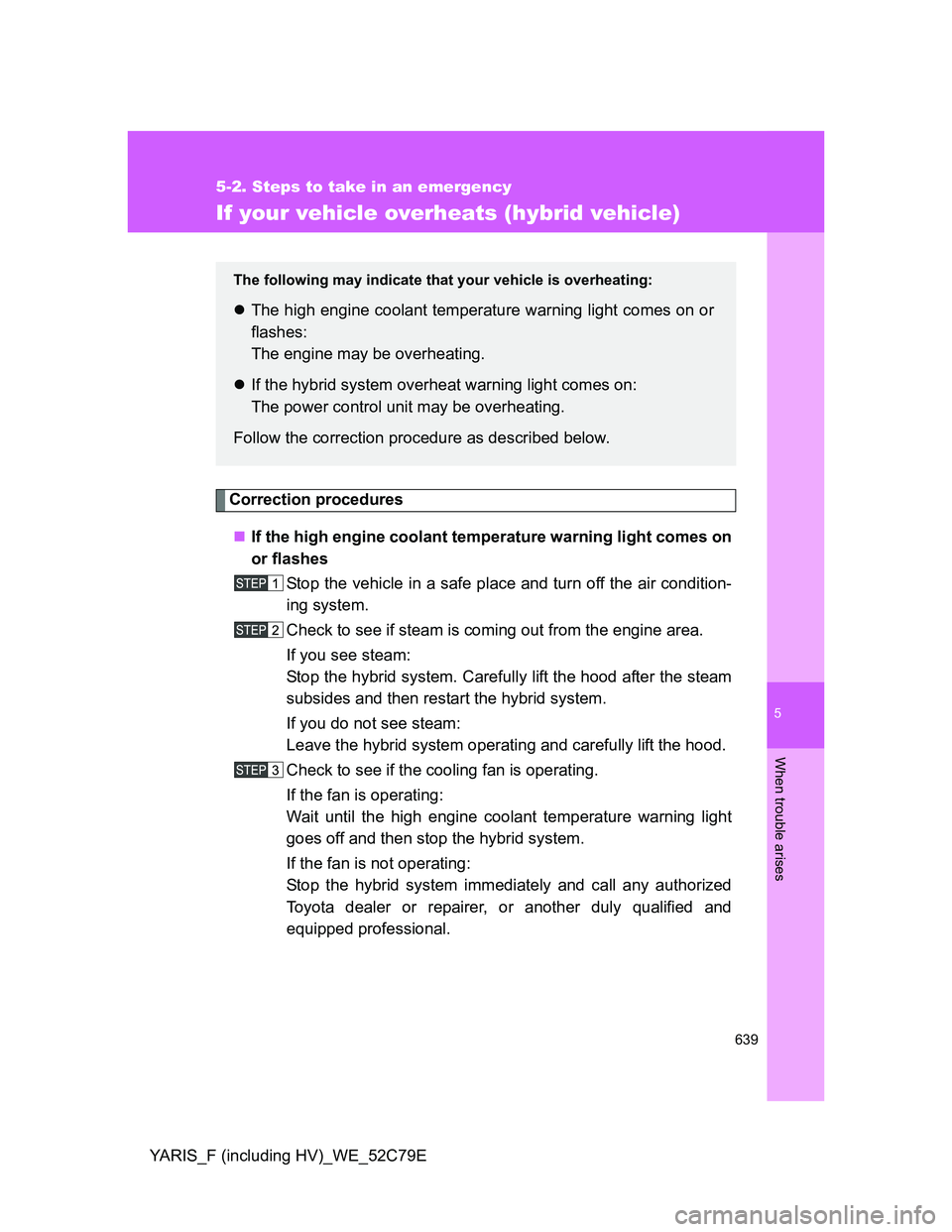
5
639
5-2. Steps to take in an emergency
When trouble arises
YARIS_F (including HV)_WE_52C79E
If your vehicle overheats (hybrid vehicle)
Correction procedures
If the high engine coolant temperature warning light comes on
or flashes
Stop the vehicle in a safe place and turn off the air condition-
ing system.
Check to see if steam is coming out from the engine area.
If you see steam:
Stop the hybrid system. Carefully lift the hood after the steam
subsides and then restart the hybrid system.
If you do not see steam:
Leave the hybrid system operating and carefully lift the hood.
Check to see if the cooling fan is operating.
If the fan is operating:
Wait until the high engine coolant temperature warning light
goes off and then stop the hybrid system.
If the fan is not operating:
Stop the hybrid system immediately and call any authorized
Toyota dealer or repairer, or another duly qualified and
equipped professional.
The following may indicate that your vehicle is overheating:
The high engine coolant temperature warning light comes on or
flashes:
The engine may be overheating.
If the hybrid system overheat warning light comes on:
The power control unit may be overheating.
Follow the correction procedure as described below.
Page 640 of 704
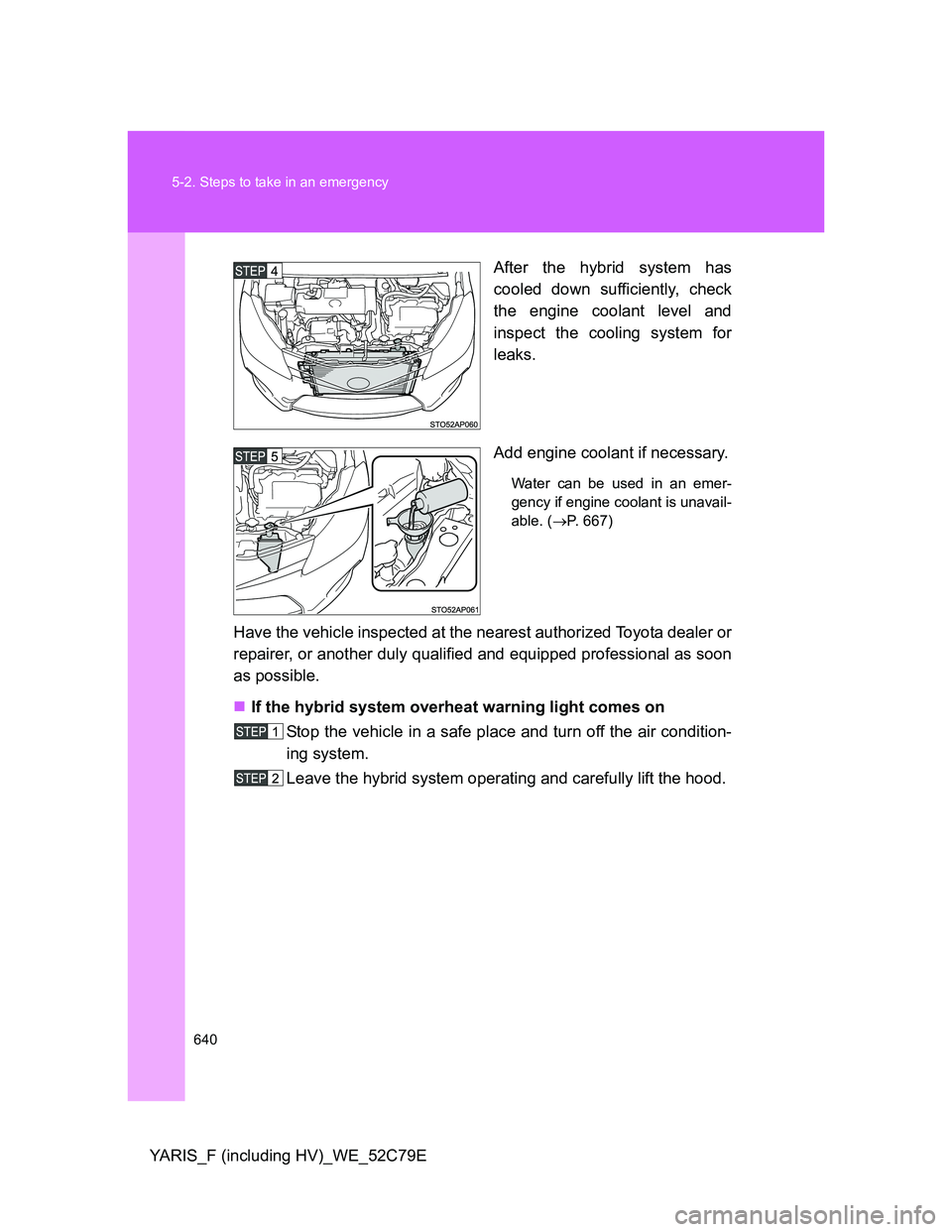
640 5-2. Steps to take in an emergency
YARIS_F (including HV)_WE_52C79EAfter the hybrid system has
cooled down sufficiently, check
the engine coolant level and
inspect the cooling system for
leaks.
Add engine coolant if necessary.
Water can be used in an emer-
gency if engine coolant is unavail-
able. (P. 667)
Have the vehicle inspected at the nearest authorized Toyota dealer or
repairer, or another duly qualified and equipped professional as soon
as possible.
If the hybrid system overheat warning light comes on
Stop the vehicle in a safe place and turn off the air condition-
ing system.
Leave the hybrid system operating and carefully lift the hood.